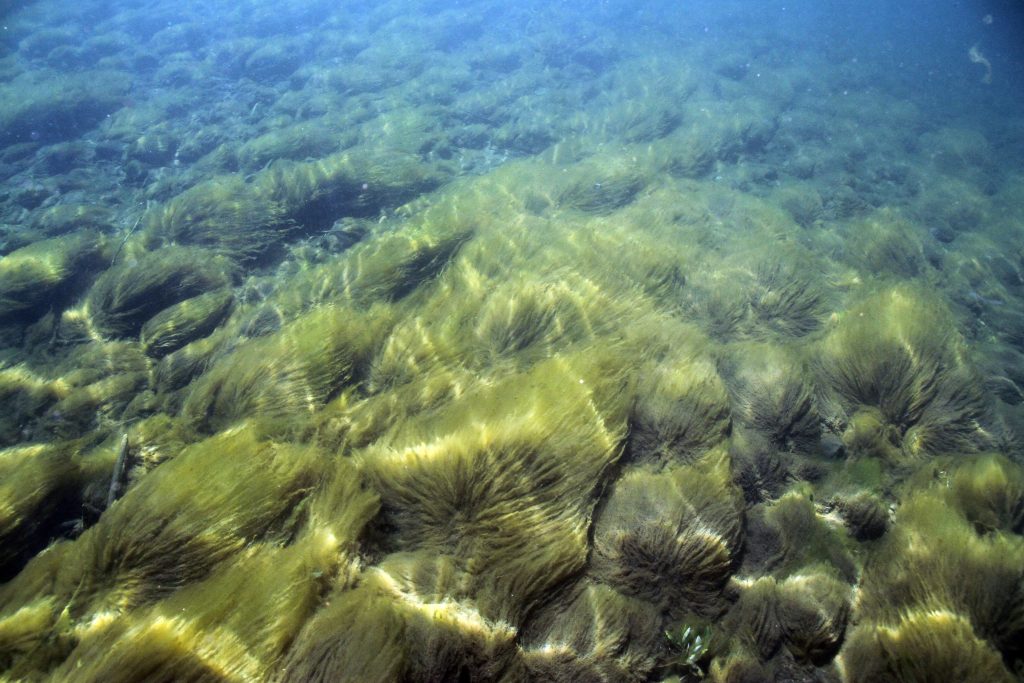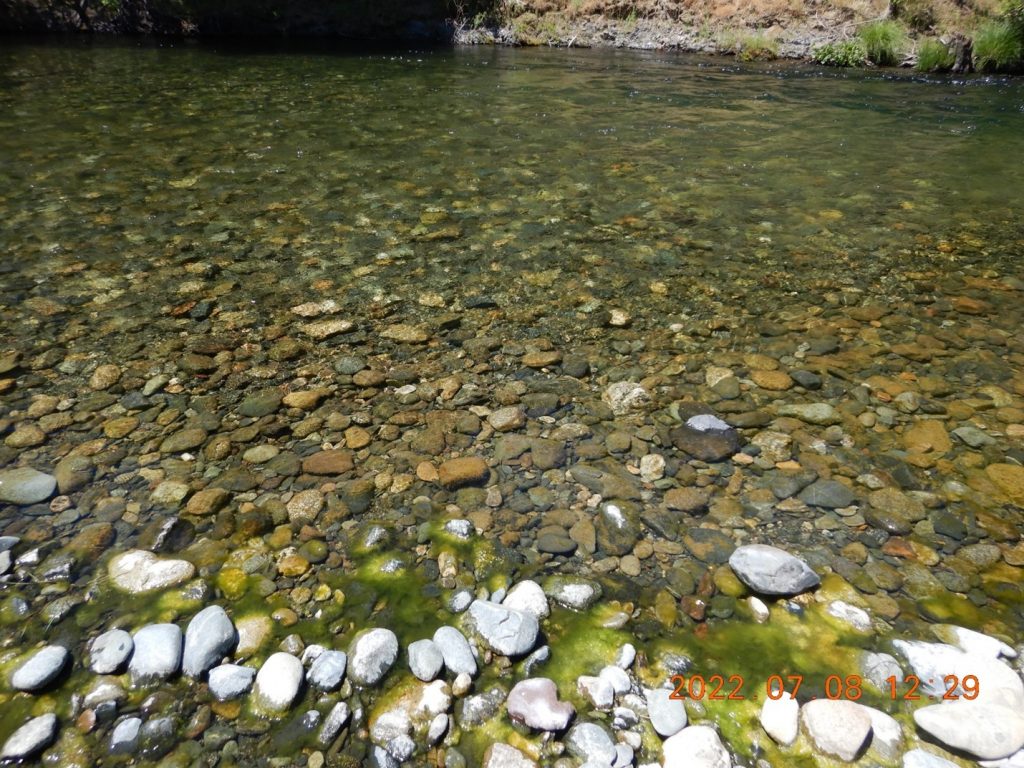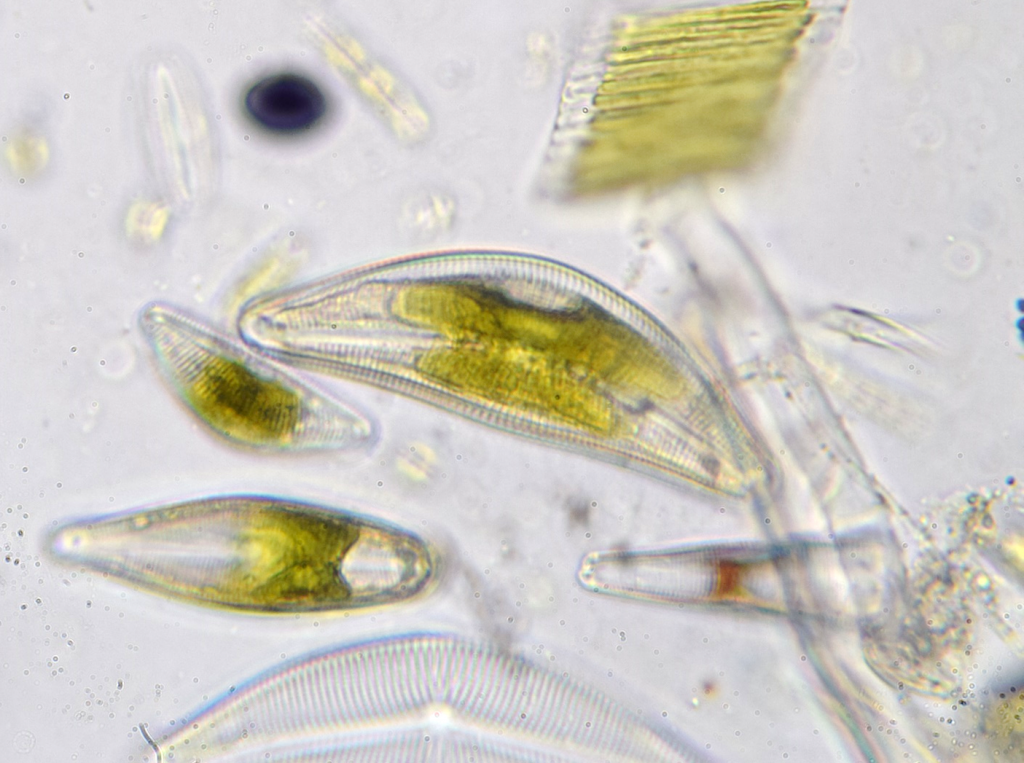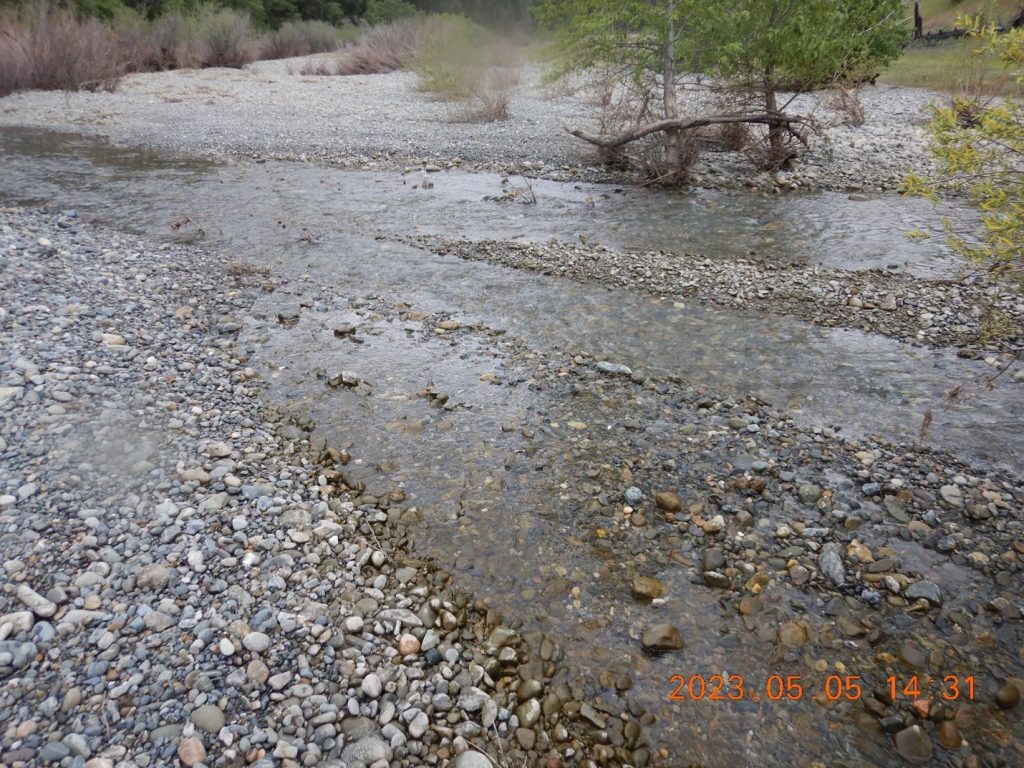
Algae are an important component of a natural river ecosystem. They photosynthesize, converting light into sugar for usable biological energy that forms the foundation of most foodwebs. Cold, oligotrophic (nutrient-poor) rivers such as the Trinity are generally not perceived as having a lot of algae. Back in 2018 a bloom of algae in the ‘restoration reach’ of the Trinity (roughly Lewiston to Helena) raised concerns; the bloom brought greater visibility of algae than we had seen in the Trinity in recent memory.
For TRRP scientists, those concerns translated to numerous questions. But questions that should be overlaid on the large body of literature from countless scientific studies done elsewhere. That literature shows (repeatedly) a number of fundamental patterns:
- A broad diversity of algae is natural in cold rivers like the Trinity.
- Young salmonids feed on small invertebrates that come both from the terrestrial environment and from within the river where algae is a primary food source.
- In the river, algae grow primarily on the river bottom (it is “benthic”) while algae suspended in the water column (“planktonic”) is prevented from becoming thick by the swift outflow of the water.
- Algae can be scoured from the river bottom during large floods, forming a reset for the benthic environment (what ecologists call a ‘disturbance’).
Studies by Dr. Mary Power (U.C. Berkeley) and her associates, primarily in the nearby Eel River, had gone further with the studies of disturbance. They found that while floods scour algae, they also scour some of the larger benthic invertebrates, particularly caddis fly larvae. Caddis fly larvae consume large amounts of algae and build cases around themselves from wood and sand to prevent fish from eating them. Their studies found that floods are necessary for controlling caddis fly populations so that algae may rebuild, that chironomid larvae (nonbiting midges) then become more abundant, and then young salmon have more food available.
Prior to 2018, TRRP scientists had their hands full with issues higher up the food chain and thus more directly related to salmon production; algae had not been specifically studied within the Trinity restoration reach from an ecological point-of-view. Questions arose… Was the bloom inappropriate for the Trinity? How much algae ‘ought’ the Trinity have? Are the types of algae in the Trinity appropriate for producing chironomid larvae and thus fish food? How does the abundance of algae in the Trinity correspond to natural flows or scheduled dam releases?
In 2020 I began monitoring algae with a simple method to address these questions while not detracting from the ongoing focus on salmon. I have been regularly measuring an index of algal abundance based on their visibility in underwater photography. I have also been sampling the algae in winter and summer to identify the types of algae present. A report from the first year of sampling is available at https://www.trrp.net/library/document/?id=2549. A second, multi-year report should be completed in 2024.

The algae in our focal reach of the Trinity River can be roughly placed into 3 groups: cyanobacteria (once known as ‘blue-green algae’), filamentous algae, and diatoms.
Cyanobacteria
Cyanobacteria are commonly found in summer and winter; they are a regular component of Trinity algae. This can sound scary at first, as some cyanobacteria produce cyanotoxins that make water dangerous. Calothrix is common in several tributaries where it forms a brownish skin-like covering over rocks, but is not considered dangerous for water quality. Others that can be problematic for water quality if they build up in abundance are found frequently in the river and tributaries. However, I have only seen them in large quantity once, in standing water of a tributary stream that had essentially stopped flowing and heated up during summer. Cyanobacteria are known to be most problematic in warm, still water and that seems to fit the Trinity where nuisance blooms have been confirmed in the lower river in relatively still edge-waters and last summer in Lewiston Lake, also with edge waters that can warm substantially.
![Cladophora Algae. [Eric Peterson, TRRP/Reclamation]](https://www.trrp.net/wordterrain/wp-content/uploads/2024/01/Cladophora-2-1024x768.jpg)
Filamentous algae
Filamentous algae (photos to right and at top of page) are generally the most visible, forming long swaths that wave in the current. The predominant filamentous algae in the Trinity and its tributaries is Cladophora, a type that is well known from many aquatic environments. While Cladophora is a direct food source for some invertebrates that become food for fish, it also hosts abundant diatoms, which I will get to in a moment. Other filamentous algae are commonly present as well, although they provide less value for the food-web that supports salmon. Places on the Eel river that have been described as productive for Chinook can have far more algae than I have ever seen in the Trinity River, so blooms like we saw in 2018 may be ecologically healthy even though they look disconcerting to us humans.
. . .
Photo: Cladophora Algae. [Eric Peterson, TRRP/Reclamation]

Diatoms
Diatoms are amazing single-celled algae… They form cell walls of silica (glass) with intricate patterns that look almost like spirograph art under a microscope, and many are actively mobile! Some also are capable of capturing nitrogen, making them a particularly valuable food source for invertebrates, which then become a food source for young salmon. These diatoms tend to have an orange color, so when aging Cladophora looks orange in the river, it actually is becoming covered with nutritious diatoms. Diatoms also live directly on rocks, where they can build up to form a slippery surface. When this “scum” of diatoms is removed from a river rock and placed under a microscope, not only is the beauty of those glass cell walls revealed, but also bazillions (OK – not a scientific term) of Chironomid larvae… fish food!


The timing of algae in the Trinity River seems to be in an unnatural state. Algae tend to build up until a flood scours them away. Most of my studies have been in critically dry years without out sufficient flooding to remove algae. Algae may be seen by most people in summer, but have been peaking in abundance in winter… early winter for tributaries, late winter for the river. However, in 2023 I was able to monitor algae before and after several significant floods. The first scoured algae from tributaries, but only scoured algae in the mainstem river below Canyon Creek (because releases from the dam remained low and the river didn’t flood sufficiently above Canyon Creek). Where scoured, algae typically redeveloped within my two-month sampling cycle. Similarly, when floodplains are inundated for several weeks, productive algae communities form.
. . .
Photo: A floodplain in the Junction City area that remained wet for several weeks allowed diatoms (the brownish color on these rocks) to thrive.
While I lack specific data on the effect on invertebrates (and thus fish food), the pattern corresponded well with the studies by Dr. Power as well as observations from an ongoing invertebrate study being done in the Trinity. Indications are that Trinity and Lewiston dams, which prevent floods in winter, are preventing the ecological disturbance that builds algae communities to feed chironomid larvae for an optimal food supply as young salmon hatch and emerge from gravels. Traditional ROD flows that don’t flood the river until April leaves an overly mature algae community (and invertebrates) in place while salmon fry emerge, then scours away the algae (the base of the food chain) when young salmon populations are peaking. A shift in flow management to provide those scouring flows in winter should set the stage for more natural algal growth as well as optimal food supplies for emerging young salmon.

Dr. Eric Peterson – Data Steward
Eric grew up in Weaverville, hiking in the Trinity Alps and exploring East Weaver Creek. A natural biologist from an early age, he completed a B.S. in biology and botany at Humboldt State University in 1995, and a Ph.D. at Oregon State University in 2000 in plant ecology with a focus on lichens and forestry. Eric worked as the vegetation ecologist for State of Nevada’s Natural Heritage Program for about 8 years, covering all corners of the state and developing techniques for mapping invasive annual grasses with satellite imagery. Eric joined TRRP in 2009 to manage Trinity River data and coordinate its use across the many offices of our partnership but also works with a focus on river ecology and is conducting a study of algae growth in the river and tributaries.
